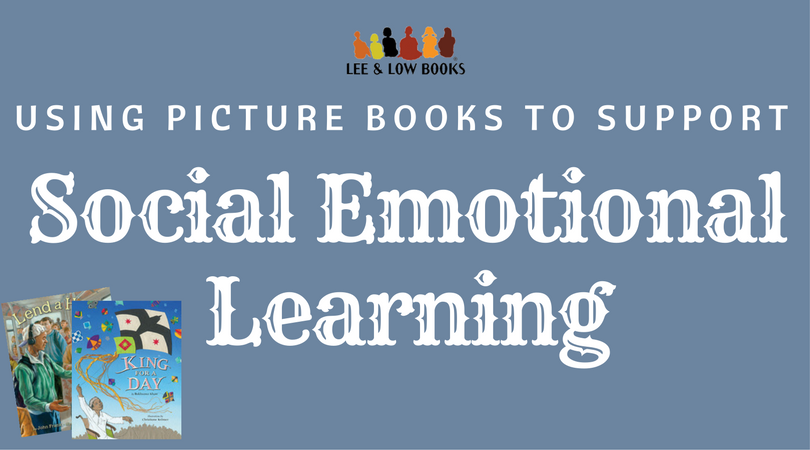
Today we are pleased to share this guest post from Librarian and Diversity Coordinator Laura Reiko Simeon on using picture books to support social and emotional learning (SEL). Welcome, Laura!
One day a new sixth grader walked into my school library, wandered over and gazed longingly at the picture book shelves, and then told me sadly that at her old school her teacher told her she wasn’t allowed to read them because they were below her reading level. I bit back my initial uncensored opinion of said teacher and mildly replied that the wonderful thing about picture books was that you could enjoy them at any age–and that no one here would stop her from borrowing whatever she liked!
This story connects to a project I developed that is currently in its seventh year. It’s taken various forms and spanned various grade levels from K-4 to K-8, but the goals have remained the same:
- To make conversations about diversity something that happen naturally and routinely, not just when there is a problem to be solved.
- To cultivate all teachers’ cultural competency skills. This helps avoid the impression that some teachers are fostering a “personal agenda” by bringing these conversations into the classroom, and reinforces our school’s commitment to creating a welcoming and inclusive environment.
- To remind students that social justice issues are not a thing of the past, solved long ago. They are also not just about one dimension of being human—not just about race or gender, for example, but about many overlapping facets of our existence.
Teachers are incredibly busy, so I support them by choosing a different picture book each month and creating a handout with related resources, background information, and discussion questions of varying complexity. In recent years the books have been integrated with the monthly social-emotional learning traits selected by our counselors, giving them even greater relevance.
Why picture books?
Picture books are ideal because they are infinitely flexible: a 5-year- old and a 12-year-old can enjoy the same picture book while understanding it in dramatically different (but equally valid) ways. The interplay and interdependence between the text and illustrations promote thoughtful analysis and the brevity of the text leaves room for the reader to contribute his or her own interpretations. With only 10-15 minutes of reading time you can present complex ideas to a group of students and foster rich conversations.
old and a 12-year-old can enjoy the same picture book while understanding it in dramatically different (but equally valid) ways. The interplay and interdependence between the text and illustrations promote thoughtful analysis and the brevity of the text leaves room for the reader to contribute his or her own interpretations. With only 10-15 minutes of reading time you can present complex ideas to a group of students and foster rich conversations.
How did we do it?
First, I did a trial run during library storytimes, carefully recording students’ questions and my responses across various grade levels. The concrete examples helped reassure any nervous teachers that the children’s responses were positive, and their curiosity was not something to fear. Next, we brought in a diversity trainer for a valuable day of professional development. Then we took a deep breath and plunged right in.
How did it go?
Overall it has been transformative. A veteran kindergarten teacher told me that one book, Let’s Talk about Race by Julius Lester, inspired the single best classroom discussion she’d ever witnessed. Another said that she has seen her skills and comfort level with diversity discussions grow dramatically over the years thanks to this project. The response from children has been equally enthusiastic! We began to incorporate the books into our annual Martin Luther King, Jr. Day assemblies, using them as a jumping off point for performances, illustrating the ways that the values Dr. King espoused have resonated throughout the decades and across continents.
What are the questions like?
For Munro Leaf’s classic The Story of Ferdinand, the questions start with ones that allow any kindergartener or first grader to talk about the constraints of gender stereotyping, such as “If Ferdinand had been a girl called Fernanda, do you think everyone would have expected her to be fierce and rough? Why or why not?”
At the other end of the spectrum, the following questions provoked much discussion and quite emotional responses from our middle school students: “What do you think of Ferdinand’s mother’s decision to let him be? Should she have tried to get him to be more like the other bulls? Should parents always accept their children just as they are?”
Another book we used with great success was Sixteen Years in Sixteen Seconds: The Sammy Lee Story by Paula Yoo, which we connected to that month’s social-emotional learning trait of patience. Some of the questions for this book were:
- What kinds of things did Sammy’s father sacrifice when he came to America? In what ways did he need to be patient?
- What can we learn from the way Sammy respected his father’s sacrifices and the goals he had for him instead of just doing what he wanted? How does this show patience?
- Why can it be good to compromise instead of doing just what you want or just what someone else wants? Can you think of a time when compromising led to a better solution? Did you have to be patient while you worked things out?
- When Sammy wasn’t allowed to go to the prom because he wasn’t white, what could the white students have done to support him?
The books you choose and the questions you write will depend in part on the makeup of your school community and the particular conversations you’d like to encourage. Whatever you do, it can be incredibly rewarding and a wonderful way to extend the use of picture books.
 About the author: The daughter of an anthropologist, Laura Reiko Simeon’s passion for diversity-related topics stems from her childhood spent living all over the US and the world. An alumna of the United World Colleges, international high schools dedicated to fostering cross-cultural understanding, Laura has an MA in History from the University of British Columbia, and a Master of Library and Information Science from the University of Washington. She lives near Seattle where she is the Diversity Coordinator and Library Learning Commons Director at Open Window School.
About the author: The daughter of an anthropologist, Laura Reiko Simeon’s passion for diversity-related topics stems from her childhood spent living all over the US and the world. An alumna of the United World Colleges, international high schools dedicated to fostering cross-cultural understanding, Laura has an MA in History from the University of British Columbia, and a Master of Library and Information Science from the University of Washington. She lives near Seattle where she is the Diversity Coordinator and Library Learning Commons Director at Open Window School.
Further Reading:
Social Emotional Learning Diverse Book List for Grades PreK-8


One thought on “Using Picture Books to Support Social Emotional Learning”
Comments are closed.